10 Basic Ingredients of a Successful Thriller
At the 2008 Maui Writers Conference, bestselling thriller writer Gary Braver (Skin Deep) said that dread drives thrillers. To captivate an audience (and agents and publishers), Braver offers these 10 essential ingredients for a successful thriller.
People often confuse the mystery and thriller genres. While it's true that they often overlap, there’s a distinct difference: A mystery follows an intellectual protagonist who puts together clues to solve a crime after it's been committed, and a thriller details the prevention of a crime before it has been committed.
At the 2008 Maui Writers Conference, bestselling thriller writer Gary Braver (Skin Deep) said that dread drives thrillers. You know who the good guys and bad guys are. Dull moments will lose an audience, and writers can't afford to lose an audience, even for one page.
To captivate an audience (and agents and publishers), Braver offers these 10 essential ingredients for a successful thriller.
10 Basic Ingredients of a Successful Thriller
1. You need to have a good story.
Thrillers want to be thrilled. A common element in thrillers is that the protagonist will fall victim to someone else's scheme and get stuck in a moment of dread. There are only three themes in all of literature: death and rebirth (Stephen King's Misery); the hero slaying a dragon to restore the world to normalcy (James Bond, Indiana Jones); and the quest to make life better (The Da Vinci Code). Know which theme fits your story.
2. Write about the underdog.
Tell your thriller from the point of view of the person with the most to lose. The protagonist gives the story character. Give him baggage and emotional complexity.
3. Multiple points of view can give you great range in a thriller.
They allow you inside the heads of many characters, which can build more dramatic tension and irony.
4. Open your book with an action scene.
Don't put biographical information or exposition in Chapter 1 (do that later). Introduce the crime—which tells you the stakes—and introduce the hero and villain, and even some obstacles the protagonist may face.
Don't sacrifice style—use metaphors and good language—but stick with action.
5. Early on, make clear what your protagonist wants and what he fears.
You should know what the protagonist wants and how he would end the novel if he were writing it.
There are two quests: Stopping the bad stuff from happening (In The Silence of the Lambs, it's to stop Buffalo Bill from killing) and dealing with the character's baggage (for Clarice to be a good, professional FBI agent in a [then] male-dominated profession).
Think Cinderella: Her main quest is to get to the ball. It's about liberation. When she gets to the ball she finds freedom.
6. Make your characters miserable.
Ask what the worst thing is that could happen to your protagonist and make it worse. Give them grief, false hope, heartaches, anxiety, and near-death experiences. We don't want our protagonist to win until the end.
7. Your main characters have to change.
It has to be an emotional change that shows growth and victory over some of his baggage. In The Silence of the Lambs, Clarice is stronger and tougher at the end and she gets a good night's sleep.
8. Pacing must be high: Strong Narrative Thrust.
Each scene should reveal something new, no matter how slight it is. Don't tell us about stuff that has nothing to do with the story. The villain has a ticking clock, so there's no time to waste on pages with useless information. Short paragraphs and white space are good. Consider using cliffhangers at the end of every chapter, albeit a sudden surprise or provocative announcement.
9. Show—don't tell.
Avoid the passive voice. Use action verbs (He heard the screams in his bedroom). Avoid adverbs—they are cheesy and cheap ways of telling instead of showing. Don't start sentences with "-ing" words (“He stared” vs. “Staring at the …”). Make the subject and verb close and upfront in the sentence.
10. Teach us something.
Make sure your audience has learned about something—an animal, medical treatment, social issue—so we walk away with more knowledge.









